The Impact of Climate Change on the Functioning of Drainage Systems in Industrial Areas—A Case Study
Abstract
1. Introduction
2. Materials and Methods
2.1. Study Area
2.2. Precipitation Characteristics
2.3. Hydrodynamic Modelling of Stormwater Drainage System
3. Results
3.1. Simulations for Scenario I
3.2. Simulations for Scenario II
3.3. Simulations for Scenario III
4. Discussion
5. Conclusions
- The least overloading of the stormwater drainage system was recorded when the catchment was loaded with the model rainfall developed from Błaszczyk’s formula. This is the model on which the sewerage system is designed and there should be no sewer malfunctions for it. However, changes in the catchment characteristics (increased sealing) relative to the design conditions have led to increased inflow of rainwater into the system, which translates into problems in stormwater drainage.
- Using up-to-date maximum precipitation data in the hydrodynamic model (model rainfall developed from the PMAXTP) translates into achieving higher system overloads and demonstrating system malfunctions (presence of flooding). These changes are evident in the increased inflow of rainwater to the reservoirs—an increase of 53.1% and 44.5% for reservoir ZR-1 and ZR-2, respectively.
- The drainage system shows insufficient hydraulic capacity, causing localised rainwater overflow to ground level. To reduce the number and volume of node flooding, it is necessary to adapt the system to accommodate the increased rainwater flows resulting from climate change and the progressive development of the SEZ. It is recommended to implement additional rainwater retention facilities (reservoirs). Additionally, it would be beneficial to consider the introduction of blue–green infrastructure or rainwater harvesting systems for the Zone’s own use. These solutions could support the area in adapting to climate change.
Author Contributions
Funding
Institutional Review Board Statement
Informed Consent Statement
Data Availability Statement
Acknowledgments
Conflicts of Interest
Abbreviations
| BGI | Blue–Green Infrastructure |
| EIP | Eco-Industrial Park |
| IDF | Intensity–Duration–Frequency |
| LID | Low Impact Development |
| SEZ | Special Economic Zone |
| SWMM | Storm Water Management Model |
References
- Szalińska, W.; Otop, I. Evaluation of spatio-temporal rainfall patterns with selected indicators for extreme event identification. Woda Sr. Obsz. Wiej. 2012, 12, 269–282. [Google Scholar]
- Wartalska, K.; Kotowski, A. Model hyetographs of short-term rainfall for Wroclaw in the perspective of 2050. Atmosphere 2020, 11, 663. [Google Scholar] [CrossRef]
- PN-EN 752: 2017; Drain and Sewer Systems Outside Buildings—Sewer System Management. PKN: Warsaw, Poland, 2017.
- Kaźmierczak, B.; Kotowski, A. Weryfikacja Przepustowości Kanalizacji Deszczowej w Modelowaniu Hydrodynamicznym; Oficyna Wydawnicza Politechniki Wrocławskiej: Wrocław, Poland, 2012. [Google Scholar]
- Nowakowska, M.; Kotowski, A. Metodyka i Zasady Modelowania Odwodnień Terenów Zurbanizowanych; Oficyna Wydawnicza Politechniki Wrocławskiej: Wrocław, Poland, 2017. [Google Scholar]
- Kotowski, A. Podstawy Bezpiecznego Wymiarowania Odwodnień Terenów. Sieci Kanalizacyjne (t. I); Obiekty Specjalne (t. II); Wydawnictwo Seidel–Przywecki: Warsaw, Poland, 2015. [Google Scholar]
- Hermida, L.; Sánchez, J.L.; López, L.; Berthet, C.; Dessens, J.; García-Ortega, E.; Merino, A. Climatic trends in hail precipitation in France: Spatial, altitudinal, and temporal variability. Sci. World J. 2013, 2013, 494971. [Google Scholar] [CrossRef]
- Kundzewicz, Z.W.; Kanae, S.; Seneviratne, S.I.; Handmer, J.; Nicholls, N.; Peduzzi, P.; Mechler, R.; Bouwer, L.M.; Arnell, N.; Mach, K.; et al. Flood risk and climate change: Global and regional perspectives. Hydrolog. Sci. J. 2012, 59, 1–28. [Google Scholar] [CrossRef]
- Schiermeier, Q. Increased flood risk linked to global warming. Nature 2011, 470, 7334. [Google Scholar] [CrossRef]
- Siekmann, M.; Pinnekamp, J. Indicator based strategy to adapt urban drainage systems in regard to the consequences caused by climate change. In Proceedings of the 12th International Conference on Urban Drainage, Porto Alegre, Brazil, 11–16 September 2011. [Google Scholar]
- Ahmed, S.; Tsanis, I. Climate Change Impact on Design Storm and Performance of Urban Storm-Water Management System—A Case Study on West Central Mountain Drainage Area in Canada. J. Waste Water Treat. Anal. 2015, 7, 229. [Google Scholar] [CrossRef]
- Dąbrowski, W.; Dąbrowska, B. The likely impact of climate change on sewerage systems dysfunction. Gas Water Sanit. Eng. 2012, 1, 17–20. [Google Scholar]
- Saboia, M.A.M.; Souza Filho, F.A.; Araujo Junior, L.M.; Silveira, C.S. Climate changes impact estimation on urban drainage system located in low latitudes districts: A study case in Fortaleza-CE. Braz. J. Water Resour. 2017, 22, 1–15. [Google Scholar] [CrossRef]
- Bezak, N.; Šraj, M.; Mikoš, M. Copula-based IDF curves and empirical rainfall thresholds for flash floods and rainfall-induced landslides. J. Hydrol. 2016, 541, 272–284. [Google Scholar] [CrossRef]
- Rak, J.R.; Wartalska, K.; Kaźmierczak, B. Weather risk assessment for collective water supply and sewerage systems. Water 2021, 13, 1970. [Google Scholar] [CrossRef]
- Arnbjerg-Nielsen, K. Quantification of climate change effects on extreme precipitation used for high resolution hydrologic design. Urban Water J. 2012, 9, 57–65. [Google Scholar] [CrossRef]
- Zhou, Q. Urban Drainage Design and Climate Change Adaptation Decision Making. Ph.D. Thesis, Technical University of Denmark, Kongens Lyngby, Denmark, 2012. [Google Scholar]
- Arnbjerg-Nielsen, K.; Willems, P.; Olsson, J.; Beecham, S.; Pathirana, A.; Gregersen, I.B.; Madsen, H.; Nguyen, V.-T.-V. Impacts of climate change on rainfall extremes and urban drainage systems: A review. Water Sci. Technol. 2013, 68, 16–28. [Google Scholar] [CrossRef] [PubMed]
- Semadeni-Davies, A.; Hernebring, C.; Svensson, G.; Gustafsson, L.G. The impacts of climate change and urbanisation on drainage in Helsingborg, Sweden: Combined sewer system. J. Hydrol. 2008, 350, 100–113. [Google Scholar] [CrossRef]
- Yazdanfar, Z.; Sharma, A. Urban drainage system planning and design—Challenges with climate change and urbanization: A review. Water Sci. Technol. 2015, 72, 165–179. [Google Scholar] [CrossRef] [PubMed]
- Egger, C.; Honti, M.; Maurer, M. Impact of climate change on urban drainage system performance. In Proceedings of the 9th International Workshop on Precipitation in Urban Areas: Urban Challenges in Rainfall Analysis, St. Mortiz, Switzerland, 6–9 December 2012. [Google Scholar]
- Fratini, C.F.; Geldof, G.D.; Kluck, J.; Mikkelsen, P.S. Three Points Approach (3PA) for urban flood risk management: A tool to support climate change adaptation through transdisciplinarity and multifunctionality. Urban Water J. 2012, 9, 317–331. [Google Scholar] [CrossRef]
- Kaźmierczak, B.; Wdowikowski, M.; Nowakowska, M. Rainwater retention on the heavily industrialized areas. Ecol. Eng. Environ. Technol. 2016, 48, 107–112. [Google Scholar] [CrossRef]
- Kirshen, P.; Caputo, L.; Vogel, R.M.; Mathisen, P.; Rosner, A.; Renaud, T. Adapting Urban Infrastructure to Climate Change: A Drainage Case Study. J. Water Resour. Plan. Manag. 2015, 141, 04014064. [Google Scholar] [CrossRef]
- Act of 20 October 1994 on Special Economic Zones (Dz. U., Official Journal of 2007, No. 42, Item 274, Consolidated Text and Dz. U. of 2008, No. 118, Item 746, as Amended). Available online: https://www.global-regulation.com/translation/poland/3353674/the-act-of-20-october-1994-on-special-economic-zones.html (accessed on 1 January 2025).
- Xu, M.; Bravo de Guenni, L.; Córdova, J.R. Climate change impacts on rainfall intensity–duration–frequency curves in local scale catchments. Environ. Monit. Assess. 2024, 196, 372. [Google Scholar] [CrossRef]
- Dziopak, J.; Słyś, D. Modelowanie Zbiorników Retencyjnych Klasycznych i Grawitacyjno-Pompowych w Kanalizacji; Oficyna Wydawnicza Politechniki Rzeszowskiej: Rzeszów, Poland, 2007. [Google Scholar]
- Bisaga, W.; Bryła, M.; Kaźmierczak, B.; Kielar, R.; Kitowski, M.; Marosz, M.; Miętek, B.; Ozga-Zieliński, B.; Tokarczyk, T.; Walczykiewicz, T.; et al. Modele Probabilistyczne Opadów Maksymalnych o Określonym Czasie Trwania i Prawdopodobieństwie Przewyższenia—Projekt PMAXTP; Institute of Meteorology and Water Management—National Research Institute: Warsaw, Poland, 2022. [Google Scholar]
- Molla, A.; Mitra, C.; Vasconcelos, J. Assessment of and Solutions to the Stormwater Management System of Auburn University Campus in Auburn, Alabama. J. Water Manag. Model. 2022, 30, C488. [Google Scholar] [CrossRef]
- Pachaly, R.L.; Vasconcelos, J.G.; Allasia, D.G.; Bocchi, J.P.P. Evaluating SWMM capabilities to simulate closed pipe transients. J. Hydraul. Res. 2022, 60, 74–81. [Google Scholar] [CrossRef]
- Ferreira, J.P.; Ferras, D.; Covas, D.I.; Kapelan, Z. Improved SWMM modeling for rapid pipe filling incorporating air behavior in intermittent water supply systems. J. Hydraul. Eng. 2023, 149, 04023004. [Google Scholar] [CrossRef]
- Geller, V.G.; Tao, Y.; Lokhandwala, A.; Vasconcelos, J.G.; Wright, D.B.; Hodges, B.R. Evaluating SWMM Modeling Performance for Rapid Flows on Tunnels with Geometric Discontinuities. J. Hydraul. Eng. 2025, 151, 04024052. [Google Scholar] [CrossRef]
- Błaszczyk, W. Spływy deszczowe w sieci kanalizacyjnej (Wytyczne do normatywu). Gaz Woda I Tech. Sanit. 1954, 9, 262–271. [Google Scholar]
- Kotowski, A.; Kaźmierczak, B.; Dancewicz, A. Modelowanie Opadów do Wymiarowania Kanalizacji; Wydawnictwo Komitetu Inżynierii Lądowej i Wodnej PAN: Warsaw, Poland, 2010. [Google Scholar]
- Kourtis, I.M.; Nalbantis, I.; Tsakiris, G.; Psiloglou, B.; Tsihrintzis, V.A. Updating IDF Curves Under Climate Change: Impact on Rainfall-Induced Runoff in Urban Basins. Water Resour. Manag. 2023, 37, 2403–2428. [Google Scholar] [CrossRef]
- Martel, J.-L.; Brissette, F.P.; Lucas-Picher, P.; Troin, M.; Arsenault, R. Climate Change and Rainfall Intensity–Duration–Frequency Curves: Overview of Science and Guidelines for Adaptation. J. Hydrol. Eng. 2021, 26, 03121001. [Google Scholar] [CrossRef]
- Madsen, H.; Lawrence, D.; Lang, M.; Martinkova, M.; Kjeldsen, T.R. Review of trend analysis and climate change projections of extreme precipitation and floods in Europe. J. Hydrol. 2014, 519, 3634–3650. [Google Scholar] [CrossRef]
- CSA. Development, Interpretation, and Use of Rainfall Intensity-Duration-Frequency (IDF) Information: Guideline for Canadian Water Resources Practitioners; Canadian Standards Association: Toronto, ON, Canada, 2019. [Google Scholar]
- IPCC. Fourth Assessment Report: Climate Change 2007; The AR4 Synthesis Report; IPCC: Geneva, Switzerland, 2007. [Google Scholar]
- Berg, P.; Moseley, C.; Haerter, J.O. Strong increase in convective precipitation in response to higher temperatures. Nat. Geosci. 2013, 6, 181–185. [Google Scholar] [CrossRef]
- Kaźmierczak, B. Prognozy Zmian Maksymalnych Wysokości Opadów Deszczowych We Wrocławiu; Oficyna Wydawnicza Politechniki Wrocławskiej: Wrocław, Poland, 2019. [Google Scholar]
- Bibi, T.S.; Tekesa, N.W. Impacts of climate change on IDF curves for urban stormwater management systems design: The case of Dodola Town, Ethiopia. Environ. Monit. Assess. 2023, 195, 170. [Google Scholar] [CrossRef]
- Gebreigziabher, E.T. Analysis Rainfall Intensity—Under Climate Change for Mekele. Int. J. Tech. Res. Sci. 2020, 5, 1–11. [Google Scholar] [CrossRef]
- Tamm, O.; Saaremäe, E.; Rahkema, K.; Jaagus, J.; Tamm, T. The intensification of short-duration rainfall extremes due to climate change—Need for a frequent update of intensity–duration–frequency curves. Clim. Serv. 2023, 30, 100349. [Google Scholar] [CrossRef]
- Fowler, H.J.; Lenderink, G.; Prein, A.F.; Westra, S.; Allan, R.P.; Ban, N.; Barbero, R.; Berg, P.; Blenkinsop, S.; Do, H.X.; et al. Anthropogenic intensification of short-duration rainfall extremes. Nat. Rev. Earth Environ. 2021, 2, 107–122. [Google Scholar] [CrossRef]
- Hassan, W.H.; Nile, B.K.; Al-Masody, B.A. Climate change effect on storm drainage networks by storm water management model. Environ. Eng. Res. 2017, 22, 393–400. [Google Scholar] [CrossRef]
- Hussain, S.N.; Zwain, H.M.; Nile, B.K. Modeling the effects of land-use and climate change on the performance of stormwater sewer system using SWMM simulation: Case study. J. Water Clim. Change 2022, 13, 125–138. [Google Scholar] [CrossRef]
- Xiong, L.; Yan, L.; Du, T.; Yan, P.; Li, L.; Xu, W. Impacts of Climate Change on Urban Extreme Rainfall and Drainage Infrastructure Performance: A Case Study in Wuhan City, China. Irrig. Drain. 2019, 68, 152–164. [Google Scholar] [CrossRef]
- Andimuthu, R.; Kandasamy, P.; Mudgal, B.V.; Jeganathan, A.; Balu, A.; Sankar, G. Performance of urban storm drainage network under changing climate scenarios: Flood mitigation in Indian coastal city. Sci. Rep. 2019, 9, 7783. [Google Scholar] [CrossRef]
- Wu, J.; Wu, X.; Zhang, J. Development trend and frontier of stormwater management (1980–2019): A bibliometric overview based on CiteSpace. Water 2019, 11, 1908. [Google Scholar] [CrossRef]
- Wang, Y.; van Roon, M.; Knight-Lenihan, S. Opportunities and challenges in water sensitive industrial development: An Auckland case study, New Zealand. Int. J. Sustain. Dev. World Ecol. 2021, 28, 143–156. [Google Scholar] [CrossRef]
- Roozbahani, A.; Behzadi, P.; Massah Bavani, A. Analysis of performance criteria and sustainability index in urban stormwater systems under the impacts of climate change. J. Clean. Prod. 2020, 271, 122727. [Google Scholar] [CrossRef]
- Willems, P.; Arnbjerg-Nielsen, K.; Olsson, J.; Nguyen, V.T.V. Climate change impact assessment on urban rainfall extremes and urban drainage: Methods and shortcomings. Atmos. Res. 2012, 103, 106–118. [Google Scholar] [CrossRef]
- Zhou, Q. A review of sustainable urban drainage systems considering the climate change and urbanization impacts. Water 2014, 6, 976–992. [Google Scholar] [CrossRef]
- Krebs, P.; Larsen, T.A. Guiding the development of urban drainage systems by sustainability criteria. Water Sci. Technol. 1997, 35, 89–99. [Google Scholar] [CrossRef]
- Hellström, D.; Jeppsson, U.; Kärrman, E. A framework for systems analysis of sustainable urban water management. Environ. Impact Assess. Rev. 2000, 20, 311–321. [Google Scholar] [CrossRef]
- Zhang, F.; Zhang, L.; Wang, Y.; Wang, H. Sexual hormones in a coastal river adjacent to the Bohai Sea: Characteristic pollutants and dominantly influencing factors. Environ. Res. 2022, 212, 113133. [Google Scholar] [CrossRef]
- Jayasooriya, V.M.; Ng, A.W.; Muthukumaran, S.; Perera, C.B. Optimization of green infrastructure practices in industrial areas for runoff management: A review on issues, challenges and opportunities. Water 2020, 12, 1024. [Google Scholar] [CrossRef]
- Wu, Y.; Gao, X. Can the establishment of eco-industrial parks promote urban green innovation? Evidence from China. J. Clean. Prod. 2022, 341, 130855. [Google Scholar] [CrossRef]
- Valenzuela-Venegas, G.; Henríquez-Henríquez, F.; Boix, M.; Montastruc, L.; Arenas-Araya, F.; Miranda-Pérez, J.; Díaz-Alvarado, F.A. A resilience indicator for Eco-Industrial Parks. J. Clean. Prod. 2018, 174, 807–820. [Google Scholar] [CrossRef]
- Corder, G.D.; Golev, A.; Fyfe, J.; King, S. The status of industrial ecology in Australia: Barriers and enablers. Resources 2014, 3, 340–361. [Google Scholar] [CrossRef]
- Chen, P.Y.; Tung, C.P.; Li, Y.H. Low impact development planning and adaptation decision-making under climate change for a community against pluvial flooding. Water 2017, 9, 756. [Google Scholar] [CrossRef]
- Hu, M.; Sayama, T.; Zhang, X.; Tanaka, K.; Takara, K.; Yang, H. Evaluation of low impact development approach for mitigating flood inundation at a watershed scale in China. J. Environ. Manag. 2017, 193, 430–438. [Google Scholar] [CrossRef]
- Liu, W.; Chen, W.; Peng, C. Assessing the effectiveness of green infrastructures on urban flooding reduction: A community scale study. Ecol. Modell. 2014, 291, 6–14. [Google Scholar] [CrossRef]
- Qin, H.-P.; Li, Z.-X.; Fu, G. The effects of low impact development on urban flooding under different rainfall characteristics. J. Environ. Manag. 2013, 129, 577–585. [Google Scholar] [CrossRef]
- Zellner, M.; Massey, D.; Minor, E.; Gonzalez-Meler, M. Exploring the effects of green infrastructure placement on neighborhood-level flooding via spatially explicit simulations. Comput. Environ. Urban Syst. 2016, 59, 116–128. [Google Scholar] [CrossRef]
- Zhu, Z.; Chen, X. Evaluating the effects of low impact development practices on urban flooding under different rainfall intensities. Water 2017, 9, 548. [Google Scholar] [CrossRef]
- Bełcik, M.; Grzegorzek, M.; Canales, F.A.; Struk-Sokołowska, J.; Kaźmierczak, B. Examination of interactions between heavy metals and benzotriazoles in rainwater runoff and snowmelt in an urban catchment in Poland. Water Resour. Ind. 2024, 31, 100236. [Google Scholar] [CrossRef]
- Pamuru, S.T.; Forgione, E.; Croft, K.; Kjellerup, B.V.; Davis, A.P. Chemical characterization of urban stormwater: Traditional and emerging contaminants. Sci. Total Environ. 2022, 813, 151887. [Google Scholar] [CrossRef] [PubMed]
- Park, M.H.; Ridgeway, I.K.; Swamikannu, X.; Stenstrom, M.K. Evaluation of stormwater BMPs for implementing industrial stormwater permitting strategy. Water Sci. Technol. 2010, 62, 2558–2563. [Google Scholar] [CrossRef]
- Jiang, Y.; Yuan, Y.; Piza, H. A review of applicability and effectiveness of low impact development/green infrastructure practices in Arid/Semi-Arid United States. Environments 2015, 2, 221–249. [Google Scholar] [CrossRef]
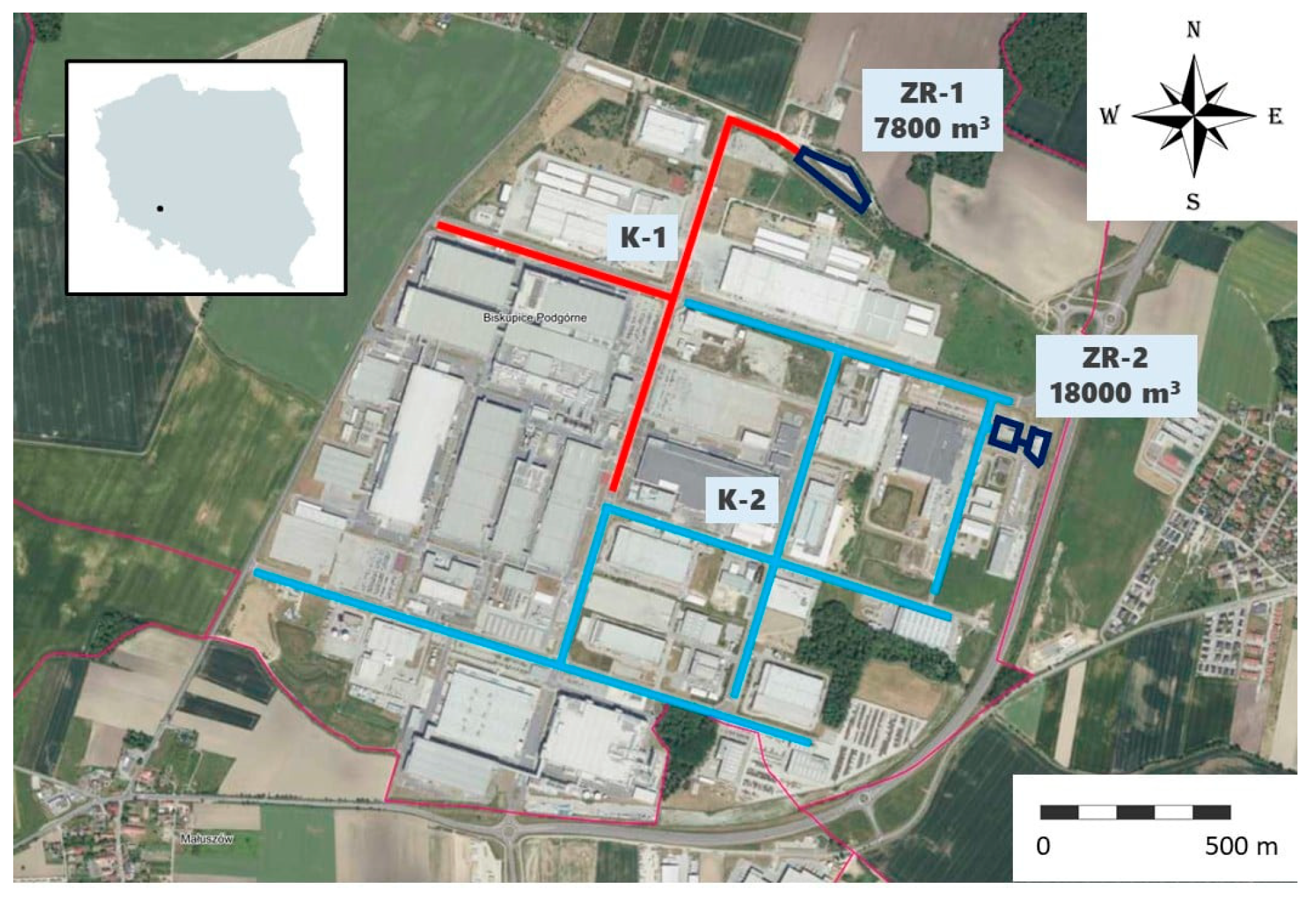
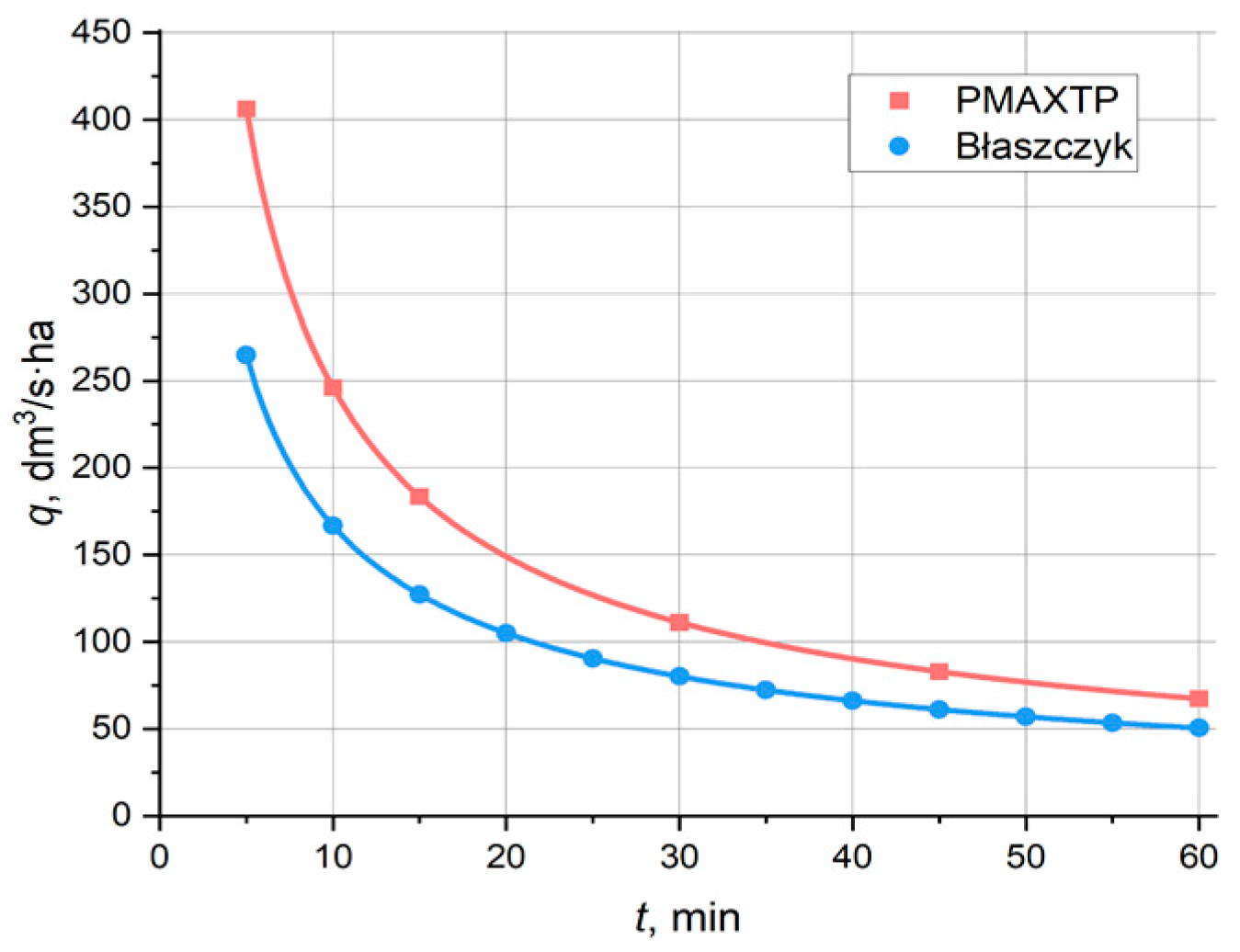

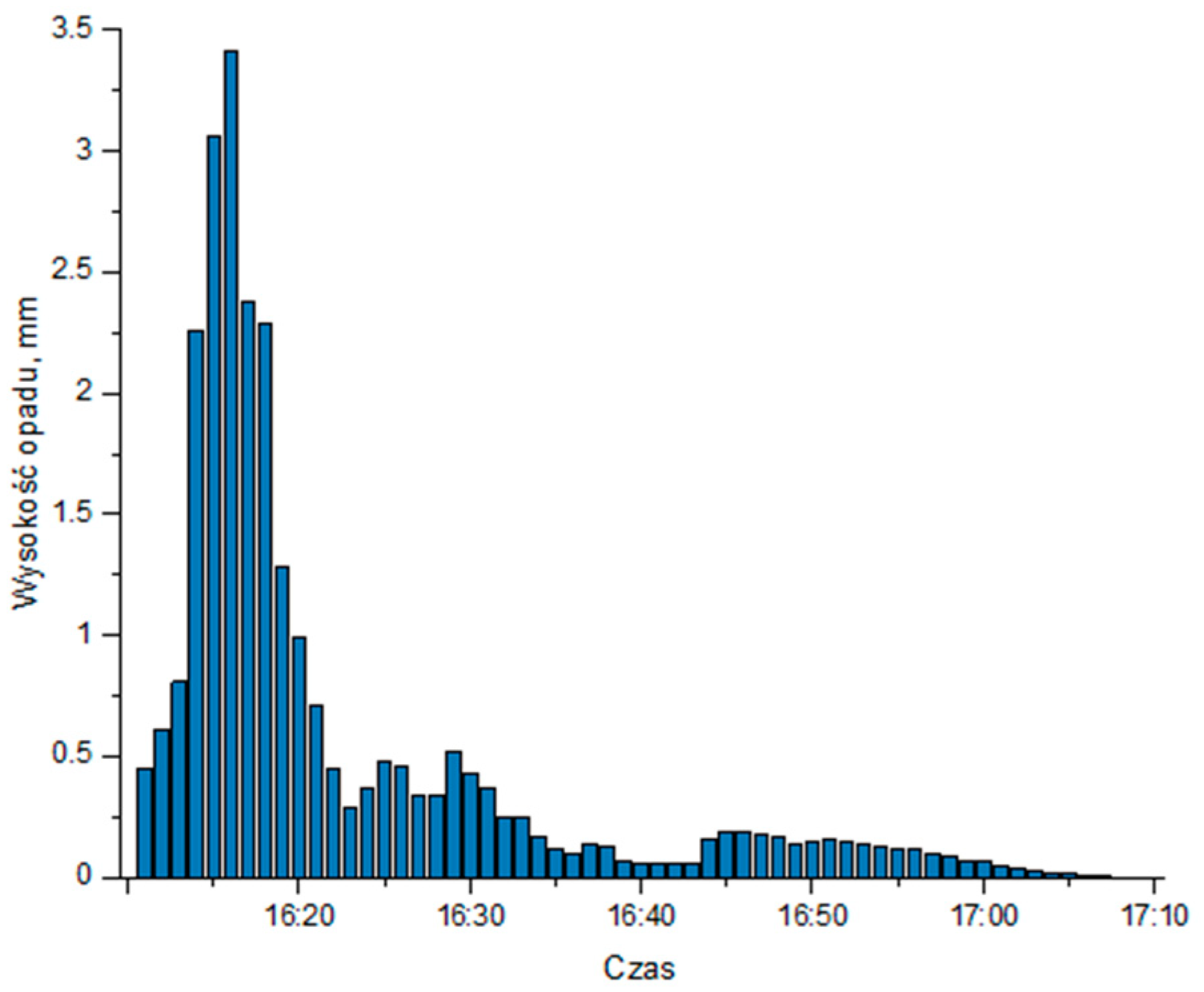
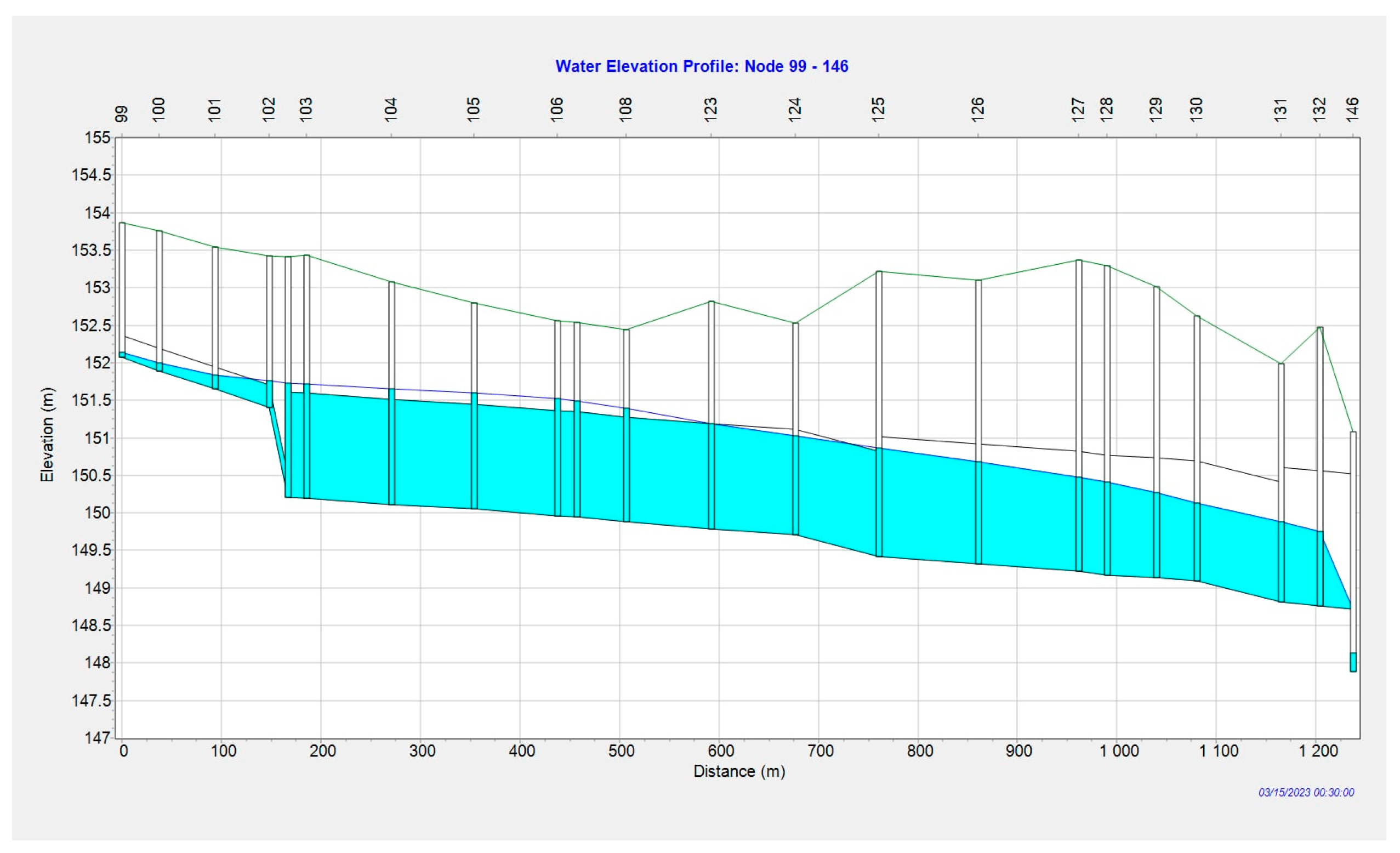

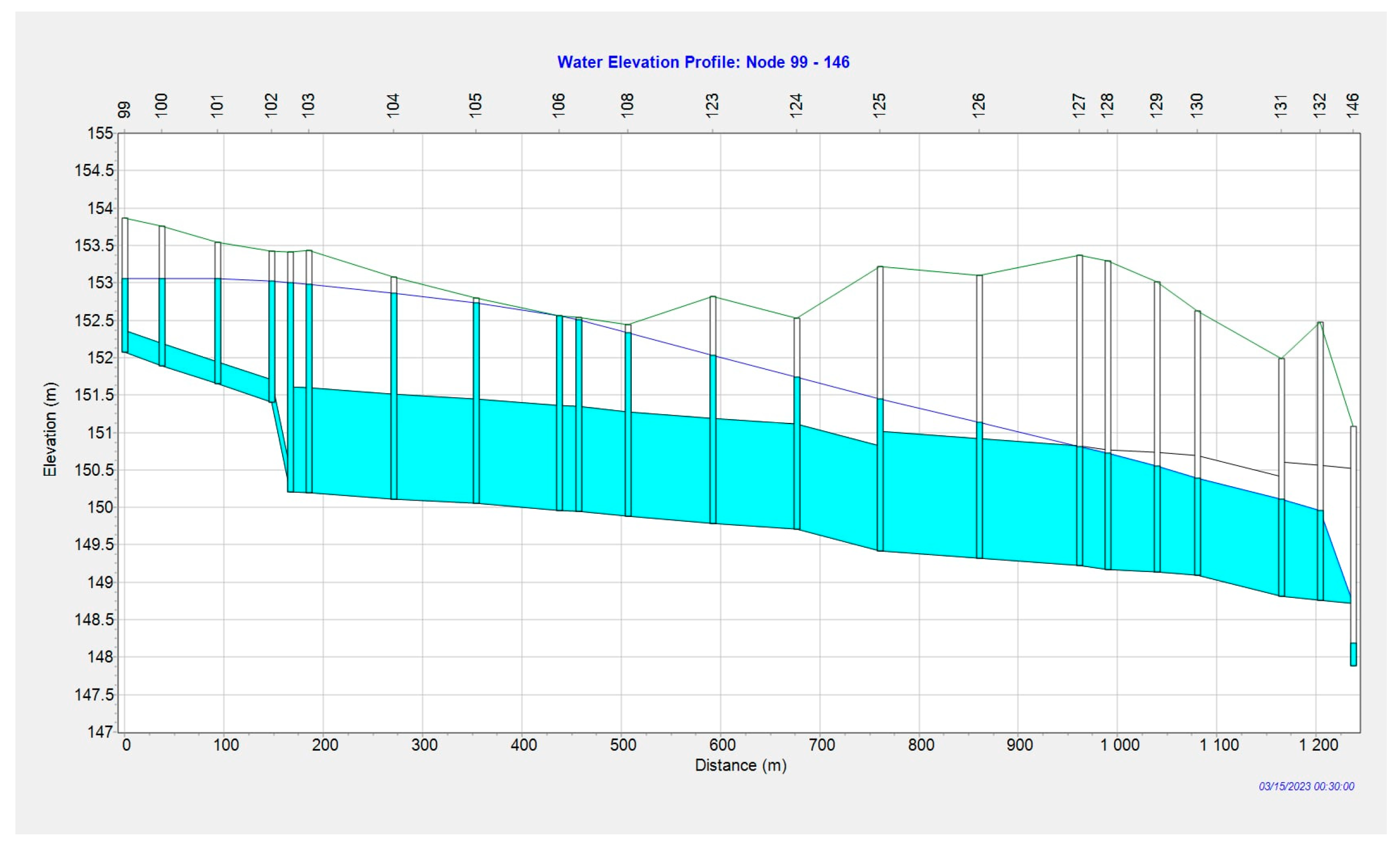
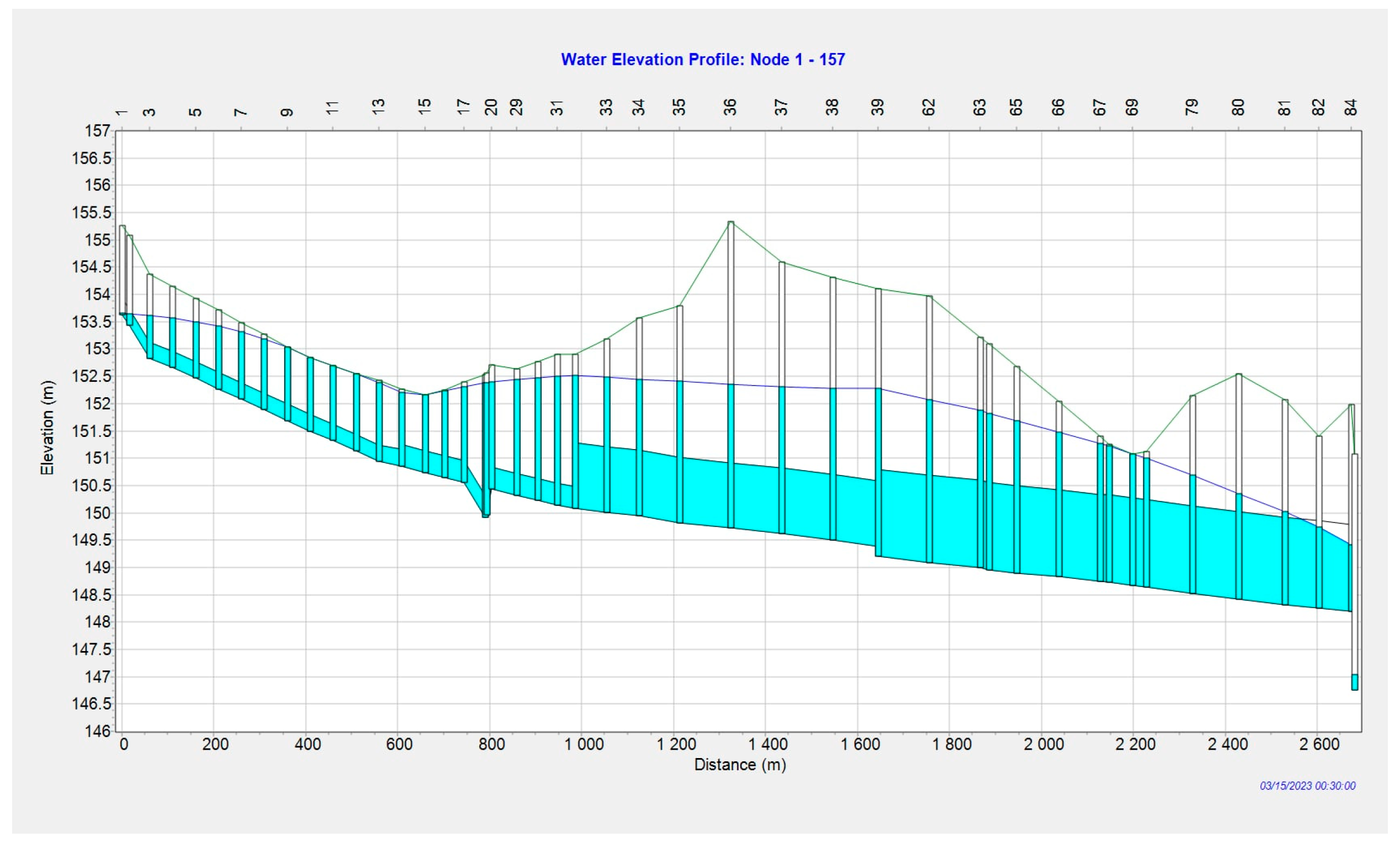
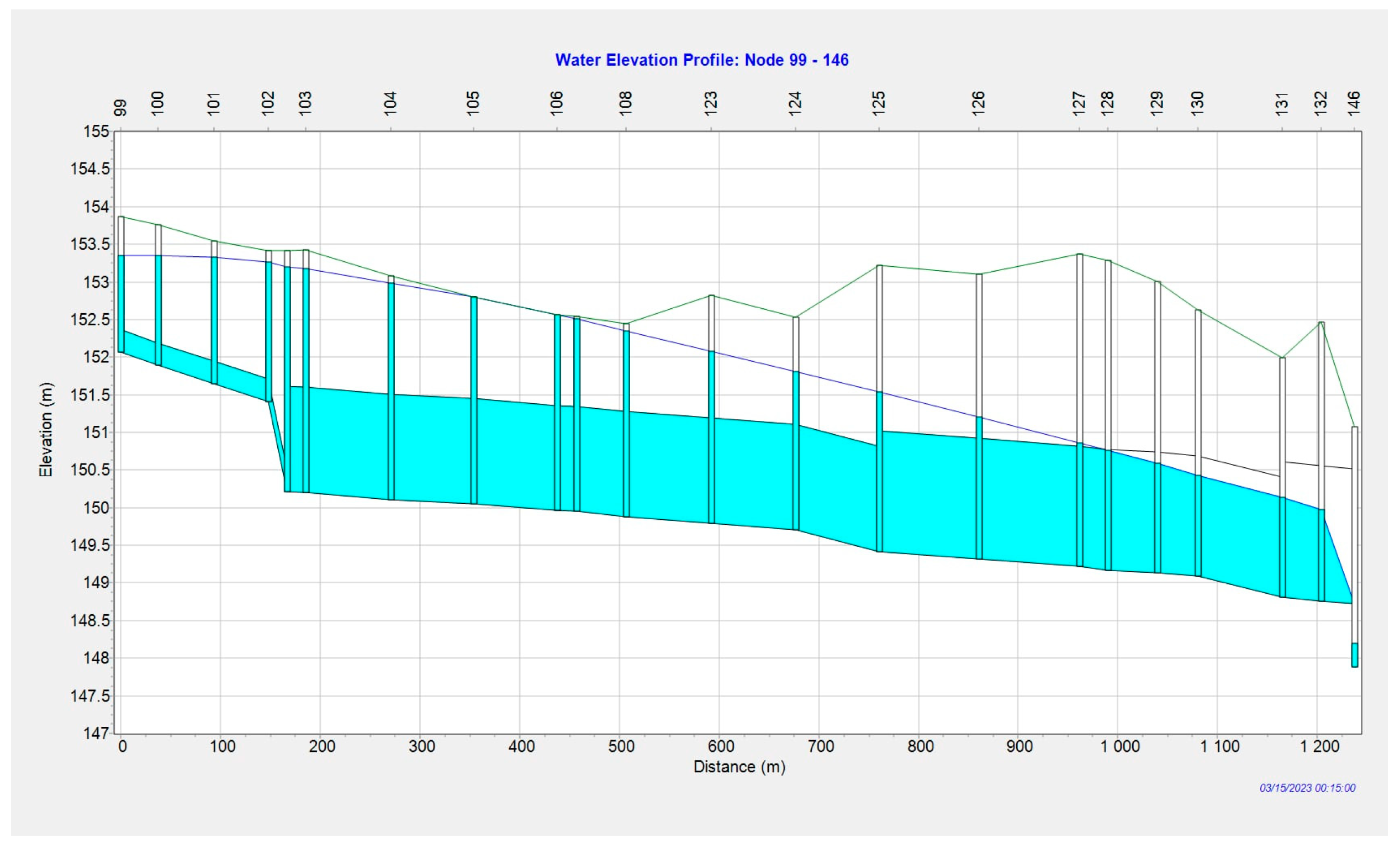
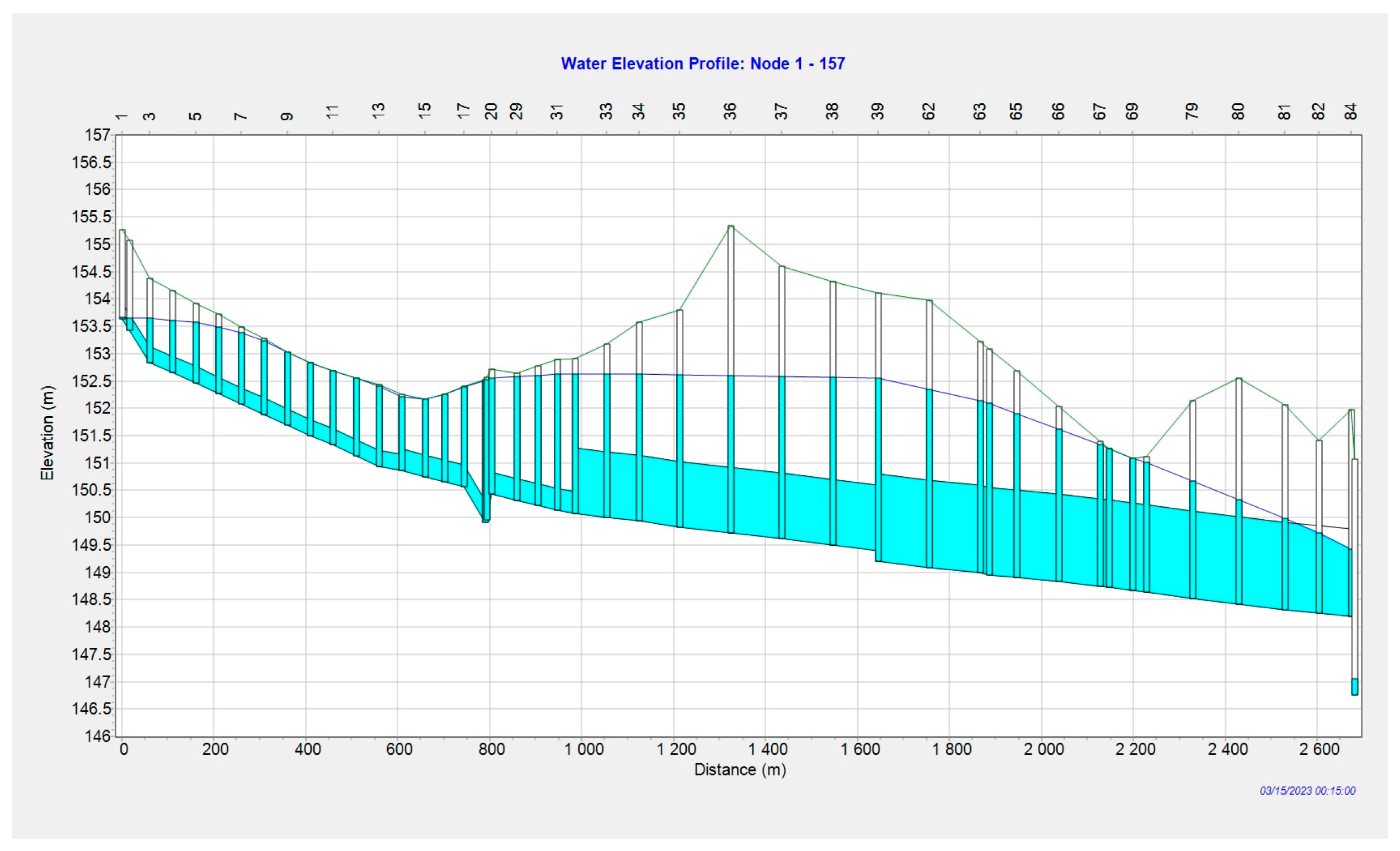
| Impact | Example Locations | Return Period 1 per C Years |
|---|---|---|
| Very low | Roads or open spaces away from buildings | 1 |
| Low | Agricultural land (depending on land use, e.g., pasture, arable) | 2 |
| Low to medium | Open spaces used for public amenity | 3 |
| Medium | Roads or open spaces adjacent to buildings | 5 |
| Medium to high | Flooding in occupied buildings excluding basements | 10 |
| High | Deep flooding in occupied basements or road underpasses | 30 |
| Very high | Critical infrastructure | 50 |
| t, Min | C = 1 | C = 2 | C = 3 | C = 5 | C = 10 | C = 30 | C = 50 |
|---|---|---|---|---|---|---|---|
| 5 | 7.6 | 9.8 | 11.6 | 12.3 | 14.4 | 18.4 | 19.9 |
| 10 | 9.1 | 12.2 | 13.8 | 15.0 | 17.5 | 22.0 | 23.8 |
| 15 | 10.2 | 13.6 | 15.1 | 16.6 | 19.4 | 24.5 | 26.5 |
| 30 | 12.3 | 15.8 | 18.3 | 20.1 | 23.3 | 29.4 | 31.7 |
| 45 | 13.7 | 17.5 | 20.4 | 22.5 | 26.2 | 32.7 | 35.3 |
| 60 | 14.9 | 19.1 | 21.9 | 24.2 | 28.3 | 35.3 | 38.0 |
| 90 | 16.6 | 21.3 | 24.6 | 27.0 | 31.5 | 39.3 | 42.1 |
| 120 | 18.0 | 23.1 | 26.6 | 29.4 | 34.5 | 42.4 | 45.4 |
| 180 | 20.3 | 25.8 | 29.7 | 32.9 | 38.2 | 47.2 | 50.4 |
| 360 | 24.5 | 31.3 | 36.1 | 39.8 | 46.2 | 57.1 | 61.2 |
| 720 | 29.9 | 38.1 | 43.8 | 48.3 | 56.0 | 69.1 | 73.4 |
| 1080 | 33.4 | 42.7 | 49.1 | 54.1 | 62.6 | 77.1 | 81.9 |
| 1440 | 36.2 | 46.3 | 53.2 | 58.6 | 67.7 | 83.3 | 88.4 |
| 2160 | 40.3 | 51.9 | 59.6 | 65.6 | 75.7 | 92.9 | 98.5 |
| 2880 | 43.7 | 56.2 | 64.6 | 71.1 | 81.9 | 100.3 | 106.3 |
| 4320 | 48.9 | 62.9 | 72.2 | 79.6 | 91.6 | 111.8 | 118.6 |
| Parameter | Scenario I | Scenario II | Scenario III |
|---|---|---|---|
| Rainfall duration | 60 min | 60 min | 60 min |
| Rainfall amount | 18.2 mm | 24.2 mm | 26.3 mm |
| Total flooding volume from the system | 0 m3 | 1275 m3 | 3032 m3 |
| Total flooding volume from the system | 3.50 m3/s | 5.36 m3/s | 5.48 m3/s |
| Rainwater collected in ZR-1 | 5341 m3 | 7034 m3 | 7800 m3 |
| Maximum emergency discharge from ZR-1 | 0 m3/s | 0 m3/s | 1.28 m3/s |
| Emergency discharge volume from ZR-1 | 0 m3 | 0 m3 | 807 m3 |
| Maximum inflow to ZR-2 | 3.57 m3/s | 5.15 m3/s | 5.54 m3/s |
| Rainwater collected in ZR-2 | 9038 m3 | 12,036 m3 | 13,067 m3 |
| Maximum emergency discharge from ZR-2 | 0 m3/s | 0 m3/s | 0 m3/s |
| Emergency discharge volume from ZR-2 | 0 m3 | 0 m3 | 0 m3 |
Disclaimer/Publisher’s Note: The statements, opinions and data contained in all publications are solely those of the individual author(s) and contributor(s) and not of MDPI and/or the editor(s). MDPI and/or the editor(s) disclaim responsibility for any injury to people or property resulting from any ideas, methods, instructions or products referred to in the content. |
© 2025 by the authors. Licensee MDPI, Basel, Switzerland. This article is an open access article distributed under the terms and conditions of the Creative Commons Attribution (CC BY) license (https://creativecommons.org/licenses/by/4.0/).
Share and Cite
Wartalska, K.; Szymczewski, S.; Domalewska, W.; Wdowikowski, M.; Przestrzelska, K.; Kotowski, A.; Kaźmierczak, B. The Impact of Climate Change on the Functioning of Drainage Systems in Industrial Areas—A Case Study. Atmosphere 2025, 16, 347. https://doi.org/10.3390/atmos16030347
Wartalska K, Szymczewski S, Domalewska W, Wdowikowski M, Przestrzelska K, Kotowski A, Kaźmierczak B. The Impact of Climate Change on the Functioning of Drainage Systems in Industrial Areas—A Case Study. Atmosphere. 2025; 16(3):347. https://doi.org/10.3390/atmos16030347
Chicago/Turabian StyleWartalska, Katarzyna, Szymon Szymczewski, Weronika Domalewska, Marcin Wdowikowski, Kornelia Przestrzelska, Andrzej Kotowski, and Bartosz Kaźmierczak. 2025. "The Impact of Climate Change on the Functioning of Drainage Systems in Industrial Areas—A Case Study" Atmosphere 16, no. 3: 347. https://doi.org/10.3390/atmos16030347
APA StyleWartalska, K., Szymczewski, S., Domalewska, W., Wdowikowski, M., Przestrzelska, K., Kotowski, A., & Kaźmierczak, B. (2025). The Impact of Climate Change on the Functioning of Drainage Systems in Industrial Areas—A Case Study. Atmosphere, 16(3), 347. https://doi.org/10.3390/atmos16030347








